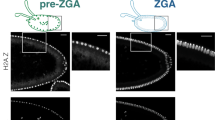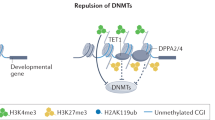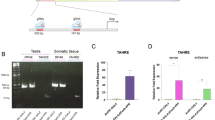Abstract
Locus control regions (LCRs) are gene regulatory elements in mammals that can overcome the highly repressive effects normally associated with heterochromatic transgene locations (for example the centromere) in mice1,2,3. Deletion of essential LCR sequences renders the cognate gene susceptible to this form of repression, so a proportion of the cells from transgenic mice that would normally express the transgene are silenced—a phenomenon known as position effect variegation4,5,6 (PEV). We show here that PEV can also occur when the transgene is non-centromeric and that the extent of variegation can be developmentally regulated. Furthermore, by overexpressing a mammalian homologue (M31) of Drosophila melanogaster heterochromatin protein 1 (HP1; refs 7,8) in transgenic mouse lines that exhibit PEV, it is possible to modify the proportion of cells that silence the transgene in a dose-dependent manner. Thus, we show M31 overexpression to have two contrasting effects which are dependent on chromosomal context: (i) it enhanced PEV in those lines with centromeric or pericentromeric transgene locations; and (ii) it suppressed PEV when the transgene was non-centromeric. Our results indicate that components or modifiers of heterochromatin may have a chromosomal-context-dependent role in gene silencing and activation decisions in mammals.
This is a preview of subscription content, access via your institution
Access options
Subscribe to this journal
Receive 12 print issues and online access
$209.00 per year
only $17.42 per issue
Buy this article
- Purchase on Springer Link
- Instant access to full article PDF
Prices may be subject to local taxes which are calculated during checkout





Similar content being viewed by others
References
Grosveld, F., van Assendelft, G.B., Greaves, D.R. & Kollias, G. Position-independent, high-level expression of the human β-globin gene in transgenic mice. Cell 51, 975– 985 (1987).
Milot, E. et al. Heterochromatin effects on the frequency and duration of LCR-mediated gene transcription. Cell 87, 105– 114 (1996).
Festenstein, R. et al. Locus control region function and heterochromatin-induced position effect variegation. Science 271, 1123–1125 (1996).
Henikoff, S. Position effect variegation after 60 years. Trends Genet. 6, 422–426 (1990).
Singh, P.B. Molecular mechanisms of cellular determination: their relation to chromatin structure. J. Cell Sci. 107, 2653– 2668 (1994).
Elgin, S.C. Heterochromatin and gene regulation in Drosophila. Curr. Opin. Genet. Dev. 6, 193–202 (1996).
Singh, P.B. et al. A sequence motif found in a Drosophila heterochromatin protein is conserved in animals and plants. Nucleic Acids Res. 19, 789–794 (1991).
Eissenberg, J.C., Morris, G.D., Reuter, G. & Hartnett, T. The heterochromatin-associated protein HP-1 is an essential protein in Drosophila with dosage-dependent effects on position effect variegation. Genetics 131, 345–352 (1992).
Reuter, G. & Spierer, P. Position effect variegation and chromatin proteins. Bioessays 14, 605– 612 (1992).
Locke, J., Kotarski, M.A. & Tartof, K.D. Dosage-dependent modifiers of positional effect variegation in Drosophila and a mass action model that explains their effect. Genetics 120, 181–198 (1988).
Aparicio, O.M. & Gottschling, D.E. Overcoming telomeric silencing: a trans-activator competes to establish gene expression in a cell cycle-dependent way. Genes Dev. 8, 1133–1146 (1994).
Weintraub, H. Formation of stable transcription complexes as assayed by analysis of individual templates. Proc. Natl Acad. Sci. USA 85, 5819–5823 (1988).
Walters, M.C. et al. Enhancers increase the probability but not the level of gene expression. Proc. Natl Acad. Sci. USA 92, 7125–7129 (1995).
Boyes, J. & Felsenfeld, G. Tissue-specific factors additively increase the probability of the all- or-none formation of a hypersensitive site. EMBO J. 15, 2496– 2507 (1996).
Saunders, W.S. et al. Molecular cloning of a human homologue of Drosophila heterochromatin protein HP1 using anti-centromere autoantibodies with anti-chromo specificity. J. Cell Sci. 104, 573– 582 (1993).
Wreggett, K.A. et al. A mammalian homologue of Drosophila heterochromatin protein 1 (HP1) is a component of constitutive heterochromatin. Cytogenet. Cell. Genet. 66, 99–103 (1994).
Brown, K.E. et al. Association of transcriptionally silent genes with Ikaros complexes at centromeric heterochromatin. Cell 91, 845–854 (1997).
Le Douarin, B. et al. A possible involvement of TIF1 α and TIF1 β in the epigenetic control of transcription by nuclear receptors. EMBO J. 15, 6701–6715 (1996).
Zhumabekov, T., Corbella, P., Tolaini, M. & Kioussis, D. Improved version of a human CD2 minigene based vector for T cell-specific expression in transgenic mice. J. Immunol. Methods 185, 133–140 (1995).
Garrick, D., Fiering, S., Martin, D.I. & Whitelaw, E. Repeat-induced gene silencing in mammals. Nature Genet. 18, 56–59 (1998).
Mamalaki, C. et al. Thymic depletion and peripheral activation of class I major histocompatibility complex-restricted T cells by soluble peptide in T-cell receptor transgenic mice. Proc. Natl Acad. Sci. USA 89, 11342–11346 (1992).
Weiler, K.S. & Wakimoto, B.T. Heterochromatin and gene expression in Drosophila. Annu. Rev. Genet. 29, 577 –605 (1995).
Lu, B.Y., Ma, J. & Eissenberg, J.C. Developmental regulation of heterochromatin-mediated gene silencing in Drosophila. Development 125, 2223–2234 (1998).
Ye, Q., Callebaut, I., Pezhman, A., Courvalin, J.C. & Worman, H.J. Domain-specific interactions of human HP1-type chromodomain proteins and inner nuclear membrane protein LBR. J. Biol. Chem. 272, 14983– 14989 (1997).
Singh, P.B. & Huskisson, N.S. Chromatin complexes as aperiodic microcrystalline arrays that regulate genome organisation and expression. Dev. Genet. 22, 85–99 (1998).
Milot, E., Fraser, P. & Grosveld, F. Position effects and genetic disease. Trends Genet. 12, 123–126 (1996).
Kleinjan, D.J. & van Heyningen, V. Position effect in human genetic disease. Hum. Mol. Genet. 7 , 1611–1618 (1998).
Shi, Y.P. et al. FISH probes for mouse chromosome identification. Genomics 45, 42–47 (1997).
Greaves, D.R., Wilson, F., Lang, G. & Kioussis, D. Human CD2 3′-flanking sequences confer high-level T-cell specific position independent gene expression in transgenic mice. Cell 56, 979 (1989).
Acknowledgements
We thank N. Dillon for supplying the mouse γ-satellite probe, A. Fischer for help with the P1 chromosomal probes, S. Uribe-Lewis for technical assistance and M. Burke for secretarial assistance. This work was partially funded by a European Commission Biotechnology Network grant (pl 970203). R.F. is an MRC (UK) Senior Fellow.
Author information
Authors and Affiliations
Corresponding author
Rights and permissions
About this article
Cite this article
Festenstein, R., Sharghi-Namini, S., Fox, M. et al. Heterochromatin protein 1 modifies mammalian PEV in a dose- and chromosomal-context- dependent manner. Nat Genet 23, 457–461 (1999). https://doi.org/10.1038/70579
Received:
Accepted:
Issue Date:
DOI: https://doi.org/10.1038/70579
This article is cited by
-
Heterochromatin protein 1 (HP1): interactions with itself and chromatin components
Biophysical Reviews (2020)
-
High-resolution mapping of heterochromatin redistribution in a Drosophila position-effect variegation model
Epigenetics & Chromatin (2009)
-
The molecular basis for stability of heterochromatin-mediated silencing in mammals
Epigenetics & Chromatin (2009)
-
HP1 controls genomic targeting of four novel heterochromatin proteins in Drosophila
The EMBO Journal (2007)
-
Breaking the silence in Friedreich's ataxia
Nature Chemical Biology (2006)



